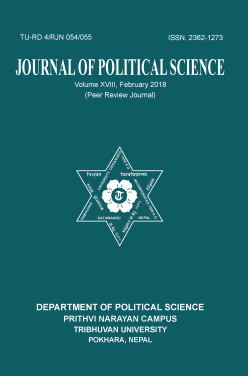Foreign Relation of Nepal with China and India
DOI:
https://doi.org/10.3126/jps.v18i0.20439Keywords:
Affair, Landlocked, Non-alignment, Diplomatic relationAbstract
Nepal is sandwiched between two giant economic and politically powerful nations - China and India. Due to its geographical proximity and historically long multi-faceted linkages to China and India, Nepal's foreign policy with China and India is not distinctly independent but is mutually interdependent. Nepal's foreign policy has always prioritized maintaining balanced relation with these two nations for safeguarding its national interests, integrity and independence. In practice, Nepal has observed friendly and cordial relation with China while the relation with India has been both friendly and hostile. Nepal is firmly committed to 'One China Policy' and had just signed OBOR (One Belt One Road) and respects India's national independence and integrity. China has shown respect to Nepal's sovereignty and has not interfered in Nepal's internal issues while India has been seen trying to influence Nepal's internal politics. The main objective of this paper is to explore the foreign relation of Nepal with, China and India. This paper makes a brief description and analysis of Nepal's foreign policy, political and economic dynamics of these relations, and new developments in Nepal-China and Nepal-India relation based on secondary sources. Election of federal, provincial and local level was held after the declaration of new constitution. Nepal's new priority in foreign relation should be economic prosperity. So, Nepal, China and India must reach a new consensus to re-build strong economic ties for mutual benefit of all.
Journal of Political Science, Volume XVIII, 2018, page: 46-61




